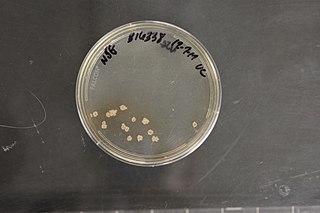Marivirga is a genus from the phylum Bacteroidota.
Dyadobacter fermentans is a Gram-negative bacterium from the genus of Dyadobacter which has been isolated from the stem of a Zea mays plant.
Leadbetterella is a Gram-negative and strictly aerobic bacterial genus from the family of Spirsomaceae, with one known species.
Runella slithyformis is a bacterium from the genus of Runella which has been isolated from a fresh water lake in Baton Rouge in the United States.
Paludibacter is a Gram-negative, strictly anaerobic, chemoorganotrophic and non-motile genus from the phylum Bacteroidota.
Paludibacter propionicigenes is a Gram-negative, strictly anaerobic, non-spore-forming and non-motile bacterium from the genus of Paludibacter which has been isolated from rice plant residue in Yamagata on Japan. Paludibacter propionicigenes produces propionate and acetate from glucose fermentation and is classified as a saccharolytic fermenter.
Marinomonas balearica is a Gram-negative and aerobic bacterium from the genus of Marinomonas which has been isolated from seagrass Posidonia oceanica.
Marinomonas pollencensis is a Gram-negative and aerobic bacterium from the genus of Marinomonas which has been isolated from the seagrass Posidonia oceanica.
Olsenella is a Gram-positive, non-spore-forming, obligate anaerobic and non-motile bacterial genus from the family Atopobiaceae. Olsenella is named after the microbiologist Ingar Olsen. Olsenella bacteria are involved in endodontic infections in humans.
Olsenella uli is a Gram-positive bacterium from the genus of Olsenella which has been isolated from the gingival crevice of humans. Olsenella uli can cause endodontic infections.
Yaniella flava is a Gram-negative, aerobic, non-spore-forming and non-motile bacterium from the genus Yaniella which has been isolated from saline soil from the Qinghai Province in China.
Aminobacterium colombiense is a Gram-negative, mesophilic, strictly anaerobic and non-spore-forming bacterium from the genus of Aminobacterium which has been isolated from anaerobic lagoon from a dairy wastewater treatment plant in Colombia.
Ferrimonas is a genus of bacteria from the family of Ferrimonadaceae.
Ferrimonas senticii is a bacterium from the genus of Ferrimonas which has been isolated from slime of the fish Arothron hispidus from the Kaneohe Bay in the United States.
Ferrimonas sediminum is a Gram-negative and facultatively anaerobic bacterium from the genus of Ferrimonas which has been isolated from sediments of an amphioxus breeding zone from Qingdao in China.
Ferrimonas pelagia is a Gram-negative bacterium from the genus of Ferrimonas which has been isolated from seawater from the Jeju Island in Korea.
Ferrimonas marina is a bacterium from the genus of Ferrimonas which has been isolated from alga from Okinawa in Japan.
Ferrimonas kyonanensis is a facultatively anaerobic and mesophilic bacterium from the genus of Ferrimonas which has been isolated from the alimentary tract of a littleneck clam from the Tokyo Bay in Japan.
Ferrimonas gelatinilytica is a Gram-negative, facultatively anaerobic and motile bacterium from the genus of Ferrimonas which has been isolated from tidal flat sediments from the Yellow Sea in Korea.

Stackebrandtia nassauensis is a bacterium from the genus of Stackebrandtia which has been isolated from soil from a roadside from Nassau in Puerto Rico.
